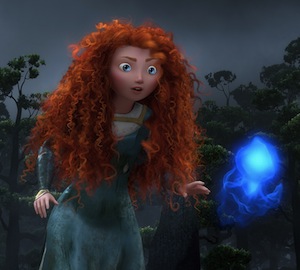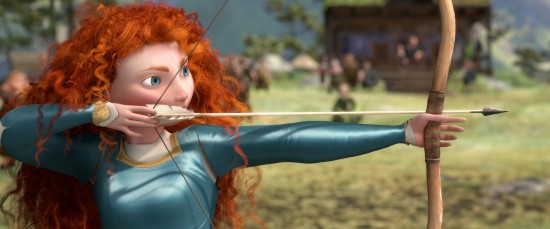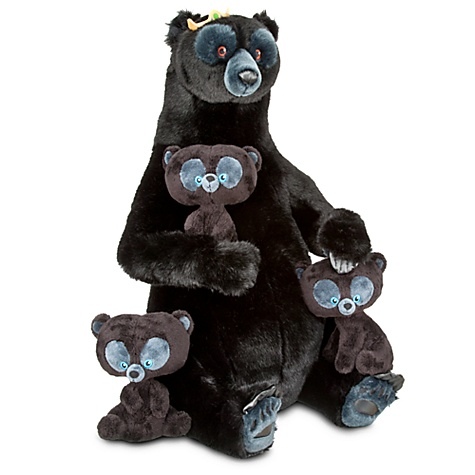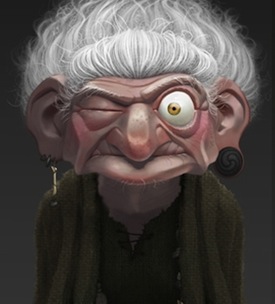The 15 Reasons 'Brave' Doesn't Feel Like A "Pixar" Film
This weekend saw the release of Pixar's latest film, Brave, a movie that easily won the weekend, garnering an overall "A" CinemaScore from appreciative audiences. Still, at only 74 percent on RottenTomatoes (Pixar's second worst), and a 7 out of 10 from Germain Lussier, it is clear there is a bit of room for dissent.
Out there in audience-land, did you notice something a little "off" about Brave? Perhaps there are lessons that can be learned, or conversations to engage in?
To provide some context, and on the off chance we have completely different taste, here are my top five Pixar efforts:
1. WALL-E
2. Up
3. Toy Story
4. Finding Nemo
5. Monsters, Inc.
Until now, the only Pixar film I flat out didn't enjoy was Ratatouille, though I admit to only having seen it once, and folks say I'd like it much more if I were to re-visit. Even Cars 2 had redeeming qualities. I can truly say I've never found a Pixar film entirely lacking, and that statement includes Brave. There's no question the film had amazing visuals, setting a new standard for excellence within the animation genre. Unfortunately, the story lacked a bit of ... what's the word I'm looking for? Ooomph. As such, I'm compelled to break down where I feel the problems were, if only to restore everyone's favorite animation house to the glory they so richly deserve.
One final note, just to head off the obligatory "comparing Brave to the rest of Pixar's work isn't entirely fair" argument, we're in complete agreement there. It's not fair, and in many ways Pixar's own ambition and commitment to excellence have raised the bar for all movies. So no, Brave isn't a bad movie on merit, it's merely an average one, which animation houses make all the time without compelling anyone to write a 3,000 word article on the subject. But within the greater context of Pixar's previous work, Brave does come up short, and I think we've got a bead on the reasons why.
Note: Massive SPOILERS follow, naturally.
 1. The Use of "Filler" Material
1. The Use of "Filler" Material
At 95 minutes, Brave is the shortest Pixar film since 2001's Monsters Inc., and it doesn't seem like they even had enough material to fill that amount. Three minutes of the film are dedicated solely to Princess Merida following blue lights. Montages and songs comprise a few minutes as well. The rest of the story involves The Queen as a bear, her running away, and Merida not wanting to get married. That's it, that's the list. As such, the film, while appearing lovely, doesn't ever fully pull at the heart strings (or the head strings) in the way previous Pixar efforts have.
2. Where is the Dramatic Tension?Brave opens with a story about the king's leg being eaten off by a giant bear. It's a rollicking tale, interrupted by Princess Merida, setting a pleasant and sturdy tone. But afterward Brave reels off a few dozen questions in a row which the audiences already knows the answer to.
Will Merida's wish to "change her fate" go awry? Yes.
Will she give her mom the cake? Yes.
Will her mom be scared and confused about being a bear? Yes.
Will the three kids be hilarious as little bears? Sure.
Will the king hate the giant bear that is his wife? Yes.
Will he actually be able to harm her? No.
Will the suitors get angry with Merida and her family for her refusal to marry? Yes.
Will it eventually work out great for everyone involved? Yes.
Brave is in the business of showing you things that can't possibly end any other way, entirely cribbing the tension.3. The Level of Dialogue
Pixar has made a brand out of quick, clever writing. For Peete's sake, Joss Whedon wrote on Toy Story!
Whereas Disney is known for songs, rapid mood shifts, and soliloquies. You probably see where I'm going with this ...
Yep, Brave is chock-full of overly expository dialogue and songs, and while they never reach the quality level of the Disney's 1989-1994 "Third Golden Age," they also completely miss the vibe of Toy Story, Up, and WALL-E. The dialogue is neither quippy nor dramatic, favoring some weird Pixar/Disney middle ground that feels more vanilla than precise.
4. The Curious Case of the Missing Whimsy
While we're on the subject of precision, it must be noted that Brave suffers from a serious lack of whimsy due to its earnest and straightforward nature. Princess Merida doesn't want to marry, she wants to change her fate, so she poisons her mom, though everyone ends up fine in the end. Everything is right there in front of you (in keeping with traditional Disney storytelling) and nothing is the least bit strange, right?
But strange is where Pixar storytelling thrives!
On paper, many of Pixar's films simply wouldn't make sense to investors. But ah, the execution. Brave? It's a film that makes perfect sense, programmed for a domestic audience that yearns for an empowered female heroine. This was a completely valid critique of Pixar prior to Brave – they'd created excellent male characters and a few interesting and original female ones. Yes, the time had come for Pixar to tackle femininity.
Only Princess Merida is at worst petulant and at best just plain "too young" to understand the demands of state. Remember, she's a princess, and the film has taken pains to point out her mother's lessons. While you could argue she, as a character, transitions, you'd have to also admit it plods along pretty much as anyone out there could guess (aside from the overarching "bear" angle). Where are the moments of pure silliness that Pixar has so excelled at? The asides of WALL-E playing music or Doug's fascination with squirrels? Missing in action.
5. The Scope of Ambition
As we continue along the "previously, on Pixar" front, WALL-E was, at its core, a silent film about a robot in a post-apocalyptic shell of Earth. On the face of it, it's as unmarketable as The Road, and any lesser studio would have laughed the concept out of the room. You can hear the booming voices of focus groups now, "Why would we want to watch a movie about a ROBOT?" But true art won out, and Pixar handed in one of the most ambitious and excellent films of the decade. For an encore, Up came out the next year, a treatise on love, aging, and loss, somehow humanizing the elderly and Doug the Dog in a manner much more befitting of a film with "Best Picture" next to it. Toy Story is the a book-ended Pixar tale that delves into the transition from boyhood to "no toy"-hood. Like Big, but without a live action Tom Hanks.
So then, what does Brave seek to accomplish? It's a fairytale (done a zillion times) about a princess (done a quadrillion times) who doesn't want to get married to someone she doesn't truly love (done a kabillion times). Fans of the film have mentioned the "mother-daughter" angle, fair, but we've seen that film before too (Hi Mamma Mia!). Even relatively recent films such as Enchanted and Tangled wipe the floor with Brave where the "let's really try something here" angle is concerned. Brave is safe, and that's a problem.
But how did they get themselves into this position?
6. Tackling a "Real Life" Culture
The Cars franchise exists in a world much like ours, thematically, though all the "life forms" are mechanical. Toy Story is in suburbia, but the toys are alive. Ratatouille comes the closest to paying homage to a real-life culture, with its focus on the gourmand process, but the protagonist is a rat, which certainly switches things up.
Juxtapose this against Brave, a movie that pretty much drinks in the Scottish highlands, winks, nudges you, and then goes, "Pretty cool, eh?" Instead of looking at everyday life and tweaking it, Brave wants to cash in on being authentic. Only that's the complete antithesis of Pixar's work heretofore – they are experts in imagination, not faithful renderings of historical cultures. As a storyteller, once you lock yourself into "The highlands are awesome" you've cut off every avenue of discovery. It's an issue. Speaking of ...
 7. Weaponry
7. Weaponry
I think it's fair to say that Pixar hasn't ignored danger in the manner of other animation houses. There are legitimate scenes of peril in Toy Story 3, and Monsters Inc. often employed "monsters" in the course of scaring children. But Brave, so far as I can tell, is the first film to bring a real life weapon into the plot. I speak of Princess Merida's bow and arrow, which she's so fond of using, and with such amazing accuracy.
But what were bows used for in the Scottish kingdom? Hunting, or war. Basically, for killing.
Now then, do we ever see Merida use her bow in this manner? Sort of, as everyone does battle against the "evil" bear prince. You can see the dilemma, as they needed to make Merida into a woman who was "better than the boys" at their own game. But here's the crux of making your subject matter "real life" – Merida should have been a hunter with that bow. She would have been Katniss from Hunger Games with her level of skill. Only the filmmakers can't play it that way, because they are trapped in a PG children's film. It's unfortunate, but they've completely hemmed themselves in, simply by choosing authenticity over imagination.
8. Sight Gags
Three small tiny brother bears! Ha! Why, there goes a Scottsman who mooned someone! Mama bear is acting like a stuffed bear! Three little bear kids! Yup, Brave is stuffed to the gills with sight gags more befitting of "lesser" animation houses.
9. The Avoidance of Andrew Stanton's Storytelling Rules ...
Remember this?
Stanton points out that Pixar, at the start, wanted to avoid the dreaded "I want" moment. You know the one, where the main character gets overly expository and exclaims to the world what he or she wants? Stanton and Pixar also wanted to avoid the "happy village song".
So what does Brave do, right off the bat with their main character, Princess Merida? "I want to choose my own future! I don't want to get married!"
And then they hit you with Julie Fowlis' "Touch the Sky"
When the cold wind is a calling/
and the sky is clear and bright/
misty mountains sing and beckon/
lead me out into the light/
I will ride, I will fly, chase the wind, and touch the sky.
I mean, what the hell? How is that not Disney 101: Intro to Songmaking? And where did my Pixar go?
 10. AnimalsFinding Nemo has animals, as does Ratatouille. You could also make the argument that Monsters, Inc. features animalistic entities. But in each of those cases, the "animals" are organic to the story, not so much plot elements as they are structural points. Nemo doesn't ever take the time to comment on the clear anthropomorphism happening in quite the same way that Brave fixates on it exclusively through the second and third acts. Brave's entire narrative hinges on one joke, and the sum total of said joke is as follows:
10. AnimalsFinding Nemo has animals, as does Ratatouille. You could also make the argument that Monsters, Inc. features animalistic entities. But in each of those cases, the "animals" are organic to the story, not so much plot elements as they are structural points. Nemo doesn't ever take the time to comment on the clear anthropomorphism happening in quite the same way that Brave fixates on it exclusively through the second and third acts. Brave's entire narrative hinges on one joke, and the sum total of said joke is as follows:
"A bear walks into the room, and that bear is Princess Merida's mom."
Sadly, the one scene approaching anything near Pixar's previous greatness involves the Bear-Queen, when she's hunting salmon. For just a moment, the lesson seems to be that the queen is tapping back into something elemental within her, and gaining greater understanding of her daughter in the process. Sadly, this tact is quickly shunted aside in favor of faux tension the as bear-queen seems be getting closer to attacking her own daughter. Which we know, given decades of animation, simply won't be happening.
11. Humans
A look-see at Pixar's canon reveals that they've only once featured a human main character, set in today's world, that didn't have superpowers. And that human was Carl from Up, who used balloons to float his house away. If you go down the list, Pixar protagonists include: toys, bugs, monsters, fish, superheroes, cars, rats, robots, Carl ... and a Scottish Highborn princess. Which isn't a dealbreaker unless you also build the story's tension the main characters desire to "control her fate," which is a motivation firmly woven into modern reality.
Allowing people to relate is a wonderful thing, but it brings a host of problems along with it that move Brave into the "just for kids" camp because thinking adults would have to think, "Well, wait, when did Scottish women gain the right to vote? If Princess Merida is allowed to choose her own mate, what about the girls working menial labor jobs? Are they extended the same protections?" And so on. This why real-word dramas are difficult to pull off, because we all have experience with the real world.
Brave wants to have it both ways – to be childish enough that you don't take it "too seriously" but still trade on your "Yeah, women should have a say!" ideals.12. The Story Arc
Pixar, to its eternal credit, heralded a fundamental change in animation storytelling techniques. Gone were easily predictable "fairy tales," replaced by modern, hyper-focused parables. No one could have predicted the giant, thin-boned people on the spaceship in the world of WALL-E. The "hero" of Up turning into a third-act foil was an act of bold storytelling. Animating toys, peering into our dream worlds, Pixar has always thrown curveballs at the audiences expectations. Not so for Brave. Once the fundamental transformation has occurred, The Queen's change-over, the story is entirely predictable as many of the questions are off the table. The only real tension comes from the previous bear-king, who could have possibly been redeemed if Brave wanted to go for all out schmaltz. To their credit, they didn't go there, but there was never much doubt in my mind that I was watching a "happy village" style of film.
13. That "Disney" Vibe
Quick, name the previous Pixar projects that directors Mark Andrews, Brenda Chapman, and Steve Purcell directed. Now add that to the number of Pixar films that writers Irene Mecchi and the three directors previously wrote on. If you came up with the number "zero" you're well on your way to understanding why Brave is an anomaly (to be fair Brenda Chapman and Steve Purcell have a story credit on Cars, along with a few dozen other people). Brenda Chapman and Irene Mecchi are Disney folk, through and through, which is precisely why Brave feels like a Disney film. Chapman directed The Prince of Egypt and wrote on The Lion King and Beauty and the Beast. Mecchi wrote on Hercules, The Lion King 1 1/2, and The Hunchback of Notre Dame. Is it any shock that writers and directors steeped in Disney storytelling cranked out a Disney story?
So then, where was Pete Docter? John Lasseter? Brad Bird? Lee Unkrich? Andrew Stanton? In other words, where were the people who made Pixar into the beloved brand it is today? Evidently the answer was "doing other stuff," which is all well and good until you realize that Brave never had a prayer of feeling like a Pixar film given the total lack of Pixar-ites involved. And don't give me the "they were executive producers on Brave!" as that could merely indicate they sat in on a few meetings. You can throw the logo on any project you like, but culture shines through, and that's why Brave feels so disparate. Every single Pixar film before Brave had Lasseter, Unkrich, Stanton, Docter, or Bird directly involved, either writing or directing, a run of twelve straight films. Not so for Brave, which might have suffered for the absence.
 14. The Use of Magic
14. The Use of Magic
Magic is a giant crutch for Brave, it's employed in transition scenes ("Let me just follow these blue lights") and in massive second and third act plot thrusts. Magic, in the case of Brave, is used to explain and inform the plot, and this is in direct thematic conflict with Pixar's methods up to this point. The toys in Toy Story are clearly magical, but the story does all the work and allows them to function under rules we can all easily follow along with. They can't be animated when humans are around, but other than that, "real" life is fair game. The Cars of Cars are sentient, but the "magic" is in the friendships. The Incredibles have super-powers, but no magic. Wall-E and Eve are robots, a triumph of tech, not magic.
The reason magic is a bastion of fairy tales is that it's a simpler form of storytelling, requiring far less heavy lifting. Sure, there are exceptions, and a few recent films have done really well (Stardust, Lord of the Rings) with the idea of magic as a modern plot construct. The risk though, and Brave falls through this trap on occasion, is using magic to explain things away, patting your audience on the head with a "just because I say so". Why does Merida's mom become a bear? Because I said so.
The "magic" method can work if you emphasize the wonder, but unfortunately Brave uses it to explain a way many critical questions. Which brings us to our final difference ...
15. Depth, and Complexity of Story
The reason Pixar's brand is so sterling? Depth and complexity, featured prominently in their previous works. Here are some of the questions Pixar has tackled over the past two decades, see if you can match the theme to the film:
What happens to our memories when we grow up?
What are the downsides to a consumer culture?
Can critics ever truly understand inspiration?
How far will a parent go to protect a child?
Where do our nightmares come from?
And so on. Pixar has always asked the big questions, made us think, made us ponder, and eschewed any predictive powers of an audience. In Pixar films villains become heroes and back again, because their rules for storytelling were the opposite of Disney's. Where Disney made you feel safe and warm, Pixar wanted us to consider the world around us.
Which leads us to Brave's central theme: Don't poison your mom. Or the thing that you know right from the start: she's not marrying any of these dudes. By making all of Merida's suitors so woefully inadequate they allow the audience that comfy, complacent feeling. Princess Merida is better than these guys! Well, yeah, but so is everyone else. So are the three little baby bears.
If great storytelling is about choices the absolute failure of Brave is that it doesn't make any, content to glide along on a sea of tremendous visuals. Brave is an overly simplistic story of Princess Merida's quest to grow up and act responsibly. Sadly, it seems destined to be forgotten as "lesser" Pixar, a victim of the true genius of their previous works.
